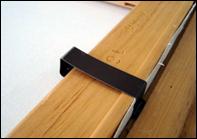 Photo 1
Photo 1
Commercial canvas clips mounted in shallow wood rabbet
When a stretched canvas or cradled box is too deep for the selected frame, there's a problem, how exactly do you get it to stay in there? Offset clips are the very best way to hold paintings on rigid backings into picture frames, though artists have come up with many other solutions, including bent nails.
Canvas clips, or bar clips, are a popular choice for artists to hold canvases that stick out beyond the back of the frame. Though this commercial solution is far better than using a bent nail, it is still not very secure, and most definitely not the professional solution (photo 1). They are a simple, one piece spring steel clip designed to fit 1-½" to 1-¾" stretcher bars, which are reusable, easy to install, and require no tools, adhesives or fasteners. Canvas clips wedge into the gap between the stretcher and the frame, and then by pressing down, the teeth pierce the inside edge of the frame rabbet.The opposite end of the clip snaps down to grab the inside of the stretcher bar to hold it in the frame. Though one clip per side is suggested by suppliers as adequate for installation, the corners of a larger canvas may warp out making this a much less secure mounting option. If you are selling framed canvases it is in your best interest—and that of your collector—to properly frame any original canvas prior to display and sale.
 Photo 1
Photo 1
Commercial canvas clips mounted in shallow wood rabbet
First comment, always select a frame that is deep enough for the stretched canvas. That said, not all artists or customers understand that theory and may be advocates of canvas clips. Time for a little consumer education.
Offset Clips
This z-shaped hardware referred to as an offset, canvas offset, offset mounting clip, z-clip, or frame clip, is a zinc plated stair-step shape with rounded corners designed for use to affix various levels of stacked frames, liners or to install canvases when the depth of a picture frame is too shallow for points. The added beauty of an offset clip is the potential for holding the canvas away from contact to a wood frame—sealed or not—thus preventing the surface from rabbet lip damage (diagram 1). They are available ⅛", ¼", ⅜", ½", ¾", 1" and 1¼" (photo 2), and come with and without holes in either end, though the holes are the best option. They are generally affixed with #6 pan or round head metal screws at a screw length long enough to hold soundly while not threading through the art board or frame.
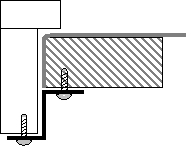 Diagram 1
Diagram 1
Stretched canvas in deep cap frame held away from lip by ¾" offset clip.
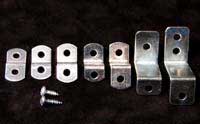 Photo 2
Photo 2
Offset clips ⅛" to 1¼".
Offsets are also great for attaching cradled boxes (diagram 2) to floaters and are the logical alternative to screweyes, pan screws or staples. Screwing to the back of a float frame does leave the screw head projecting behind, so selecting a longer offset attached horizontally prevents screw heads from touching the wall (diagram 3).
 Diagram 2
Diagram 2
Cradled box in deep float frame held with ¼"-½" offset clip.
Screw head touches wall.
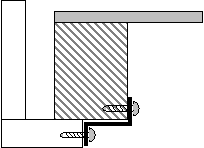 Diagram 3
Diagram 3
Cradled box in float frame with ¾" offset clip inside back.
At least four offset clips should be used per small painting, two across the top and two across the bottom. Placing additional clips at the center of each short side is a good idea and use more as the painting gets larger. Placement of offsets should be 8-10" apart around the perimeter. Though many clips come with two holes, the second hole is generally used when stacking picture frames or liners, but not necessarily for securing original art (photo 3).
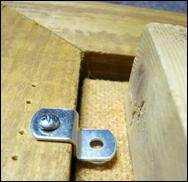 Photo 3
Photo 3
Masonite original held with ¼" offset and 3M clear bumper.
Liners and Lifters
Liners may be added to frames and stacked mouldings may be joined using the offset clip method too. A recent frame repair brought in by a customer required ⅜" clips to be added to secure a linen covered wood liner into their shallow decorative frame. Then the original egg tempera painting on hardboard—which had been backed with a ½" x 1½" pine lifter glued to the back of the panel—was fitted using ⅛" clips (photo 4), as each layer was too wide for their rabbets.
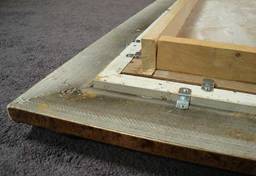 Photo 4
Photo 4
A ¼" offset clips the frame to the liner, a ⅜" offset is used to mount the painting with lifter to the frame unit.
END
Copyright © 2012 Chris A Paschke
For more articles on mounting basics look under the mounting section in Articles by Subject.
Additional information on all types of mounting is found in:
The Mounting and Laminating Handbook, Second Edition, 2002,
The Mounting And Laminating Handbook, Third Edition, 2008 and
Creative Mounting, Wrapping, And Laminating, 2000 will teach you everything you need to know about getting the most from your dry mount equipment and materials as an innovative frame designer.
All books are available from Designs Ink Publishing through this website.
Chris A Paschke, CPF GCF
Designs Ink
Designs Ink Publishing
785 Tucker Road, Suite G-183
Tehachapi, CA 93561
P 661-821-2188
chris@designsinkart.com